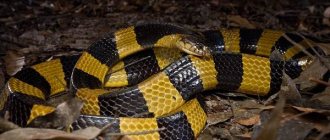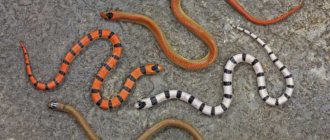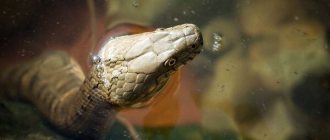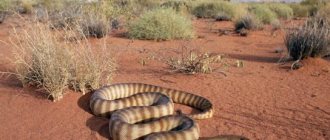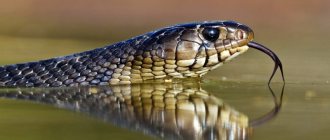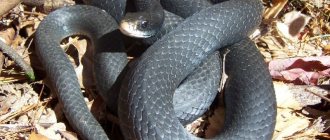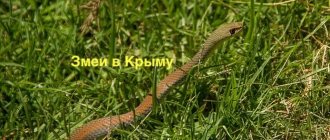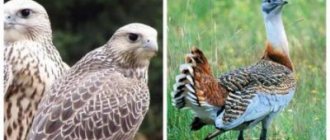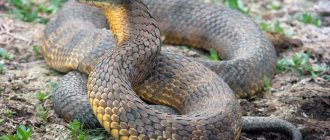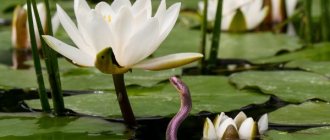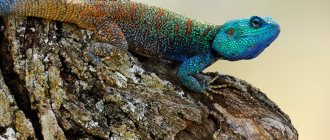Review author: “ZooVita”
Snakes have always attracted attention as one of the most interesting and mysterious animals. Cold-blooded snakes are representatives of the class Reptiles; they amaze with the abundance of varieties, wide habitats, and structural and metabolic features. For lovers of long-distance travel, it will be useful and informative to find out what reptiles live in Crimea.
Photos of Crimean snakes will allow you to get acquainted with the main representatives of the fauna and avoid meeting them in life.
Climatic features of the peninsula
The life and development of reptiles directly depends on the climatic conditions of the environment. On the Crimean peninsula there are a lot of territories with a favorable climate and conditions for the development of snakes, including in sea water.
The warm subtropical climate contributes to the massive reproduction of fauna, including snakes.
Social structure and reproduction
Photo: Steppe viper in Crimea
At the beginning or mid-April, the mating season begins for vipers - this is the approximate time of emergence from hibernation. Before the mating season, snakes live alone, rarely in large groups, but during the mating season, males look for females in small flocks.
For one female viper there are 6-8 males who organize mating games. They huddle around the female in a ball and wriggle their bodies. There are no winners or losers in this game - the female herself will choose the male she likes most.
Sometimes male steppe vipers organize tournaments. They stand in fighting poses, holding their heads high and leaning on their tails, and then hit each other with their bodies and heads. These are not bloody tournaments, since the snakes do not bite each other and do not seek to kill - the strongest snake will simply exhaust its opponent and bend his head to the ground.
Interesting fact: Such ritual fights among snakes are called dances.
After such dances, snakes prefer to rest in an open place for a day or two, simply basking in the sun. At this time, snakes are most often encountered by humans, but during this period they are the least aggressive, since they are resting.
Depending on its habitat, the pregnancy of the steppe viper lasts:
- 90 days in the southern regions;
- 130 days in Russia and northern regions.
The female brings live cubs, which are born in a softened shell and immediately hatch from it. In one clutch, as a rule, there are only 5-6 cubs, about 12-18 cm long. Under the supervision of the mother, they feed on small insects, and soon they undergo a change of skin - molting. Already in the third year of life, vipers grow and can bear offspring.
Interesting fact: Sometimes a female can lay up to 28 eggs in a clutch.
Main types of snakes in Crimea
The fauna of the peninsula is distinguished by rich species diversity. What types of snakes live in Crimea:
- The common steppe viper is the only representative of the poisonous snakes of the Crimea.
- Yellow-bellied snake.
- Medyanka.
- Leopard snake.
- The water snake is one of the most common representatives of the Reptile class on the peninsula.
An encounter with an asp can be dangerous if the snake is poisonous or there is an individual sensitivity to the toxin secreted by the reptile.
Common snake (lat. Natrix natrix)
Although the temperature in Crimea is higher than in the middle zone, some animals from it also live here. This also applies to the common grass snake. These snakes with light spots on their temples are familiar to many people. Such snakes are harmless and harmless to humans.
The average length of the snake is 1.5 meters, but there are individuals twice as long. Females are larger than males. You can meet a snake in any damp place; it often settles next to a person’s home. The main thing is that there is a body of water with standing or sluggish water nearby. They can be found in forests, floodplains, and swamps.
Living close to humans, snakes regularly become accidental victims, crawling onto the roads under the wheels of cars. The common snake swims well, but it cannot be compared with its close relative - the water snake - it almost lives in the water. Snakes feed on small mammals, fish, and amphibians.
Having met a person, anyone will try to quickly disappear from view. When caught or in extreme danger, it will try to scare off the aggressor with sharp-smelling secretions from the cloacal glands or pretend to be dead by relaxing the muscles of the body. Snakes are tamed as pets - they get along with people and protect their homes from rodents.
Common steppe viper
One of the most famous representatives of the Reptile class, which is a rather dangerous opponent. It reaches 46-48 cm in length, females are significantly larger.
A characteristic feature of the common viper is a zigzag stripe on the gray-brown background of the snake’s skin. A symmetrical pattern of dark spots is noted on the head.
A rather rare color option is completely black skin color. Such snakes are called melanistic, and this is a phenotypic trait that is subject to change throughout life.
The steppe viper is the only representative of poisonous snakes on the Crimean peninsula. Meetings with the reptile are possible in the steppes and on forest slopes, where hiking trips are often organized. A snake bite is not fatal, with the exception of an individual allergic reaction in humans.
As a rule, limited swelling, redness, and severe pain develop at the site of the bite. Specific to all vipers is the hemolytic effect of toxins, which can be expressed in a short-term increase in body temperature, severe headache, chills, and nausea.
Snake bite - symptoms and first aid
The bite of a poisonous Crimean snake does not pose a serious danger to humans. Yes, it is painful, but almost 100% of people recover on their own within 1-2 days after the attack, even without any specific treatment. Yes, sometimes there are complications after a bite - but in most cases, complications arise due to subsequent improper treatment.
What to do if you are bitten. Video advice from Dr. Komarovsky
In most cases, Crimean vipers are not very aggressive - when they see a person, they immediately crawl away, and they use their poisonous teeth to kill prey. However, in some cases, such a snake can still bite - in case of self-defense and in case of protecting a snake's nest. It should be understood that in case of contact there is no need to tease the snake - do not hit it with a stick, do not pull its tail (it is better not to even try to grab its tail), and so on. If you are bitten by a viper, then you need to do the following:
- The most important thing is don't panic. Yes, the wound may bleed, your head may hurt, and the affected area may become covered with unpleasant spots. But don’t worry, the venom of this snake is very weak and people do not die from it.
- Immediately after the attack, suck out all the poison from the wound, periodically spitting it on the ground. Both the victim himself and other people can suck out the poison. It is advisable that it be suctioned by those people who have no injuries in the oral cavity. However, if the poison gets into the oral cavity, then nothing bad will happen - the poison will easily break down in the stomach and be excreted from the body along with urine.
- The person should be given peace. To do this, find some dark place, lay a blanket on the ground and place a person on it.
- Give him water or some non-alcoholic drink, as alcohol makes the painful symptoms of the bite worse.
- To reduce the likelihood of allergies, give the victim several tablets of diphenhydramine, suprastin or some other antihistamine.
- After providing first aid, the victim must be taken to the hospital.
Yellow-bellied Snake
This reptile is the largest snake on the Crimean peninsula. It reaches 2 meters in length. The body is covered with smooth scales. In this case, the back is colored olive or brown, and the belly has an orange or bright yellow coating. Several yellow spots are located above the eyes.
The eyes have a normal structure, strongly bulging. It prefers to live in dense thickets of grapes and crawls well on trees and bushes. A reptile bite is quite painful, but the snake's venom is absolutely safe for humans.
Non-venomous snakes
Six non-venomous species of snakes live on the territory of the Crimean peninsula. However, one of them can pose a danger to humans, as it has an aggressive disposition.
Yellow-bellied Snake
It is one of the largest European snakes: sometimes reaching sizes of 200-250 cm, while males can be longer than females.
The head of the yellow-bellied stripe is small with a rounded muzzle; the intercept separating it from the neck is weakly expressed. The eyes are slightly protruding, with a round pupil. The scales are medium in size and quite smooth.
The upper part of the body is colored olive or yellow-brown, or reddish, red-cherry, and almost black individuals are also found. The belly is one color, light yellow, orange or reddish-orange.
These snakes love to settle in open areas - in steppes, semi-deserts, among scattered stones, on the slopes of ravines and gullies.
They can also be found in bushes, forest belts, gardens, vineyards, ruins of houses, and haystacks. The mountains rise to a height of 1600 meters above sea level.
They hunt rodents, lizards, amphibians, birds and some species of snakes, including snakes and vipers.
They mate in April-May, after 2.5 months the female lays 5-18 eggs, from which baby snakes about 30 cm long hatch in early autumn. They reach sexual maturity at 3-4 years, and yellow-bellied snakes live in their natural habitat from 8 up to 10 years.
These snakes are not afraid of people; when meeting them, they do not try to crawl away as quickly as possible, but, curled up in rings, make a throw towards a person at a distance of up to 2 meters, trying to get in the face. The bite of the yellow-bellied snake causes severe pain and often leaves a small scar.
Leopard climbing snake
Typically, males of this species do not exceed 100 cm in length, females can be slightly larger - up to 120 cm. This snake, distinguished by its relative thin body and unique color, is almost impossible to confuse with other related species.
The leopard snake's head is narrow and slightly elongated, its eyes are golden-orange, medium in size, and the pupil is round.
The main color of the body is grayish or pearl-gray; there are spots of brownish or reddish shades on it, reminiscent of the pattern on the skin of a leopard and bordered with a black outline.
Leopard snakes are found in Southern Europe. In addition to Crimea, they can be found, for example, in Italy, Greece, Turkey, Bulgaria, Croatia.
These snakes feed mainly on mouse-like rodents like voles. Their breeding season is May–June, with 2 to 5 young hatching in August–September.
Leopard snakes have a peaceful disposition and never attack a person first, but may try to bite in self-defense.
Four-banded climbing snake
A large snake, reaching 260 cm, but completely harmless to humans.
The head is elongated-diamond-shaped, the cervical interception is weakly expressed. The upper part of the body is usually colored in light brown, yellowish or grayish shades, while the belly is straw yellow, sometimes it has darker blurry markings in the form of spots.
A characteristic feature of snakes of this species is four narrow longitudinal stripes of dark brown color located in the upper part of the reptile’s body.
The four-striped climbing snake prefers to settle in well-warmed places where there are shady, fairly moist areas. You can meet it on the outskirts and edges of forests, in floodplains, on rocky slopes overgrown with bushes, as well as sandy wastelands, vineyards and gardens.
On cloudy days, snakes of this species hunt during the day, and on sunny and hot days, at night and at dusk.
It feeds on rodents, lagomorphs, and birds. It climbs trees perfectly, and is able to cover the distance between branches that are distant from each other through the air.
In July or August, the female lays a clutch of 4 to 16 eggs, after 7-9 weeks they hatch into cubs with an average length of 20 to 30 cm. They become suitable for reproduction at 3-4 years.
They are not aggressive towards people, and when meeting them by chance, these snakes usually try to quickly hide in the thick grass.
copperhead
Only one species of copperhead lives on the Crimean peninsula - the common copperhead. The average length of these snakes is 60-70 cm, and the tail is 4-6 times shorter than the body.
The head is almost oval in shape, the pupil is round, the eye color is amber-golden or reddish.
The scales are smooth, the upper body is colored gray, yellowish-brown or reddish-brown with copper shades. In this case, along the back there may be a pattern in the form of small blurry spots or speckles.
The belly is most often grayish in color, but it can also be any color from steel-blue to almost red, and often has dark, fuzzy spots or speckles.
A characteristic pattern is noticeable on the head of copperheads, in the form of a dark stripe running from the nostrils to the temples.
Copperheads settle in well-lit, fairly dry places, such as forest edges, forested meadows, meadows and clearings, and can also climb mountains up to 3000 meters above sea level.
This snake is diurnal, although sometimes it can be seen at dusk and even at night.
It hunts lizards, small birds, rodents, amphibians, as well as snakes, and can sometimes eat smaller individuals of its own species.
The breeding season for copperheads occurs in May, and in the summer, from 2 to 15 cubs are hatched from the eggs laid by the female, which are thin shells. Snakes of this species reach sexual maturity at 3-5 years, and copperheads live for about 12 years in total.
Copperheads do not attack people first, and they do not bite. However, if you try to grab the snake, it will hiss and lunge towards a possible enemy. If he does not want to leave her alone, he will try to scare away a possible predator using a liquid with a very unpleasant odor, which is produced in special glands.
Common snake
The snake can be easily distinguished from other snakes by the yellowish, orange or white spots on its head.
The average size of these snakes is 140 cm, but females can grow up to 2.5 meters. The head is triangular, slightly rounded on the muzzle side. The pupil of snakes is round, and not vertical, like that of poisonous snakes.
The scales are dark, grayish or even black, the belly is pale, yellowish or light gray, often interspersed with brownish-green markings.
Snakes like to settle in damp places; often these snakes can be found along the banks of rivers, lakes, as well as in wetlands and wet meadows.
These snakes are not afraid of people and often settle near populated areas, and sometimes even crawl into the basements of houses or gardens.
Snakes prefer to feed on amphibians, mouse-like rodents and small birds; they also eat large insects.
These snakes mate in the spring, after which the snake lays from 8 to 30 eggs. After 1-2 months, they hatch into cubs whose body length is 15-20 cm. They are ready to reproduce by 3-5 years of age, and in total they live for about 20 years.
These snakes are peaceful towards people and are not the first to attack. But if they are annoyed or try to cause harm, for the purpose of self-defense they can pour a thick, sharp-smelling liquid produced by special glands on a person. They rarely bite, and the wounds inflicted often become infected due to the fact that the snakes' teeth are curved and rotting food remains accumulate on them.
Water snake
A snake whose size does not exceed 1.6 meters, with females being larger than males. The head is almost oval, somewhat tapering towards the muzzle, the pupil is round.
The scales on the upper side of the body are olive, olive-gray or greenish-brown in color, with spots or stripes of a darker shade scattered on them. In addition, pure olive or black water snakes are also found.
Water snakes do not have yellow or orange markings on their heads; instead, these snakes have dark, V-shaped spots.
The water snake’s lifestyle is closely related to salty or fresh water bodies, where it mainly hunts. Moreover, more than half of its diet consists of fish, and the rest of the menu consists mainly of amphibians.
These snakes can often be seen on the Crimean estuaries, where they love to hunt fish from the goby family.
Mermen are already non-aggressive and try to avoid meeting people. If he has to defend himself, he does this with the help of a liquid with a pungent odor, which is produced in the glands located next to his tail.
Return to content
copperhead
The copperhead is a non-venomous snake, widespread throughout the peninsula. The skin of a snake can have several shades: from golden to brown (in some individuals the skin color reaches an almost black shade). Sexual dimorphism differs: females are larger and have a predominantly brown color.
A distinctive feature is two black stripes that originate from the very tip of the muzzle and pass through the center of the eye. There are several vertical black spots on the sides. The mouth contains rows of teeth, but absolutely no poisonous glands or ducts.
Copperheads love warmth, and therefore you can accidentally meet the reptile in the sun, in thickets of bushes, or on the stumps of felled trees. Representatives of this species are excellent swimmers, but avoid water. A copperhead can bite a person only in cases of extreme danger or fear.
Poisonous snakes
Of the poisonous snakes, only the steppe viper lives in Crimea, which is found mainly in the steppe and forest-steppe zones of Eurasia.
Steppe viper
A fairly large snake, the body length of which is approximately 40-60 cm, while males are often smaller than females.
Unlike the ordinary viper, whose body is wider in the middle part, the body of the steppe viper is almost the same in thickness, while it seems to be slightly flattened on the sides.
The head is slightly elongated, covered in front with small, irregularly shaped scutes, and the edges of the muzzle are slightly raised.
The scales of the snake have a grayish-brown color, while on the back there is a distinct zigzag pattern of black or dark brown. There are a number of slightly blurred darkish spots on the sides of the body. The belly is grayish, with light specks. Darker, almost black melanistic steppe vipers are very rarely found.
Most often, this snake can be found in the foothills, steppes, semi-deserts, as well as in the mountains, where they live at an altitude of up to 2700 meters above sea level.
Important! In the summer, the steppe viper is active mainly in the morning and evening hours, while in spring and autumn it prefers to hunt during the day. On land it is quite slow, but swims well and can climb onto the branches of bushes or low trees.
This snake wakes up when the air temperature reaches seven degrees, and its breeding season occurs in April–May. At the end of summer, the snake gives birth to from 4 to 24 cubs, the size of which is approximately 11-13 cm, which will become sexually mature in the third year of life.
The steppe viper can be dangerous to humans, but at the same time it is of great benefit, since it destroys not only small birds and lizards, but also agricultural pests - rodents and orthopteran insects. A significant part of its diet is locusts, which often become a real disaster for farmers.
Return to content
Leopard snake
Another interesting species of reptile is the snake snake in Crimea. The body length of an adult reaches 70 cm, with rare exceptions (the maximum recorded length is 120 cm).
The bright coloring and vibrating tip of the tail are special adaptations designed to protect against natural enemies (the crackling and vibration is reminiscent of the crackling of rattlesnakes).
For life, it chooses places with sufficient access to sunlight and rocky terrain. Prefers a climate without high humidity levels. You can meet the leopard snake in the parks of the peninsula, in the fields, and in the gardens of Crimea.
The snake is never the first to show aggression. Only in case of protection from a sudden guest does this reptile with such a bright color attack. The bite is accompanied by the simultaneous release of liquid with a specific and unpleasant odor from the cloaca.
Common copperhead (lat. Coronella austriaca)
This harmless snake is often a victim of human prejudice - it is destroyed due to some similarity with a viper. In fact, she has no venom glands and rarely bites, preferring to avoid encounters with any animal larger than herself.
The copperhead is a relatively small snake, about 70 cm in length, with a robust build and smooth scales. Its color can be varied, but most often it is gray or brown with a characteristic copper tint. A pattern of dark spots can often be seen on the snake's back. A pattern of dark stripes is also visible on the head, and the copperhead's eyes are lined with red. The color of young animals is brighter than that of adults.
Copperheads are confused with vipers more because of the banal fear of snakes among many people. If you look closely at the animal, you will notice obvious differences between these species: they have different head shapes, differences in the delineation of the cervical region, a different texture of scales and the shape of the pupils - in copperheads they are round, and in vipers they are flat and vertical.
You can meet the copperhead in various forests, clearings, forest edges, and meadows. Their favorite hiding places are stumps and fallen trees, voids under stones and abandoned animal holes. Snakes usually feed on lizards, rodents, and frogs; they also often destroy bird nests in search of nutritious eggs.
Water snake
Snakes on the peninsula are the only snakes that live in the Black Sea of Crimea. As a rule, such reptiles do not pose a danger. The most common encounters between humans and snakes occur when swimming in shallow water. The snake is a fairly large snake, reaching a length of 80-130 cm.
A distinctive feature is the pointed head, covered with symmetrically arranged scutes. The scales covering the body and tail have clearly defined longitudinal ribs. The back is colored olive or brownish.
Some individuals are characterized by the presence of dark spots arranged in a checkerboard pattern. The main difference from an ordinary grass snake is the absence of a V-shaped yellow stripe on the head.
The bite of a water snake is quite painful, but only due to bent teeth (a lacerated wound is formed) and dirt, which contributes to further infection.
